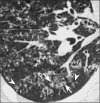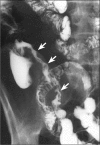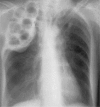Bilateral neck swelling in a 40-year-old woman with HIV
- PMID: 17948114
- PMCID: PMC2014810
- DOI: 10.1080/08998280.2007.11928329
Bilateral neck swelling in a 40-year-old woman with HIV
Figures













Similar articles
-
A bilateral cervical swelling and it is not a malignancy.Oral Surg Oral Med Oral Pathol Oral Radiol. 2012 Jun;113(6):e19-21. doi: 10.1016/j.tripleo.2011.08.011. Epub 2012 Feb 17. Oral Surg Oral Med Oral Pathol Oral Radiol. 2012. PMID: 22677025
-
[Unilateral eyelid swelling in naevus flammeus faciei. Problems in differential diagnosis of unilateral eyelid swelling].Hautarzt. 1994 Nov;45(11):792-8. doi: 10.1007/s001050050174. Hautarzt. 1994. PMID: 7822207 German.
-
A 69-year-old woman with periodic fever, facial swelling, and neck pain.Allergy Asthma Proc. 2018 Jul 1;39(4):322-325. doi: 10.2500/aap.2018.39.4139. Allergy Asthma Proc. 2018. PMID: 30095398
-
[A Case of HIV-associated Salivary Gland Disease (HSD) Presenting with Bilateral Parotid Abscesses].Nihon Jibiinkoka Gakkai Kaiho. 2016 Sep;119(9):1220-4. Nihon Jibiinkoka Gakkai Kaiho. 2016. PMID: 30035904 Review. Japanese.
-
Scrofuloderma: a forgotten disease?Skinmed. 2007 Nov-Dec;6(6):303-4. doi: 10.1111/j.1540-9740.2007.06607.x. Skinmed. 2007. PMID: 17975356 Review.
References
-
- Harisinghani MG, McLoud TC, Shepard JA, Ko JP, Shroff MM, Mueller PR. Tuberculosis from head to toe. Radiographics. 2000;20(2):449–470. - PubMed
-
- Perez-Solis D, Luyando LH, Callejo-Ortea A, Crespo-Hernandez M. Case 90: disseminated tuberculosis. Radiology. 2006;238(1):366–370. - PubMed
-
- Lucey BC, Stuhlfaut JW, Soto JA. Mesenteric lymph nodes seen at imaging: causes and significance. Radiographics. 2005;25(2):351–365. - PubMed
-
- Yang ZG, Min PQ, Sone S, He ZY, Liao ZY, Zhou XP, Yang GQ, Silverman PM. Tuberculosis versus lymphomas in the abdominal lymph nodes: evaluation with contrast-enhanced CT. AJR Am J Roentgenol. 1999;172(3):619–623. - PubMed
-
- All India Institute of Medical Sciences. The AIIMS Radiology Department abdominal tuberculosis imaging database Available at http://www.geocities.com/HotSprings/8093/abdtb.html; accessed July 15, 2007.
LinkOut - more resources
Full Text Sources
